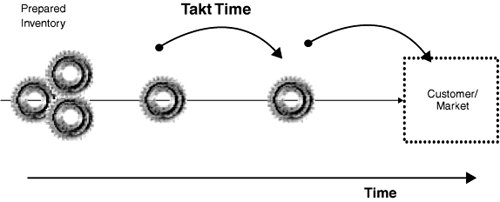Section 50. TimeTakt Time
50. TimeTakt TimeOverviewTakt (a real word, not an abbreviation) is the German word for rhythm or cadence. A common mistake here is to confuse it with TACT (Total Activity Cycle Time) or similar, which is an entirely different thing. Takt is defined as "The rate at which the end product or service must be produced and delivered in order to satisfy a defined customer demand within a given period of time." Simply put, it is the drumbeat of the market demand based on our working hours. Takt Time is calculated as If a process were perfectly balanced with the market demand, then every Takt increment an entity is processed and used by the market. See Figure 7.49.1. For example, if a process runs 24 hours a day and the market demand is 240 entities per day then If an entity is not processed (on average) each and every six minutes, the process falls behind Customer demand. In Lean Sigma terms, the processing time is known as the Global Process Cycle Time. Thus, if the Global Process Cycle Time is above the Takt Time, the process falls behind Customer demand. Likewise if the Global Process Cycle Time is less than the Takt Time of, for example, five minutes, then the process is cycling faster than Customer demand and building inventory or spending one minute in every six waiting, to avoid creating unused inventory. Figure 7.49.1. Graphical representation of Replenishment Time (versus Process Lead Time). Note that there is no mention in Takt of how quickly the process can possibly go or how quickly it is actually going, only how fast it should go to meet demand. Clearly if the work period (shift time) is less than 24 hours per day, then the process has to go proportionately faster during those times that work is actually done to meet the daily market demand. For example, if the work period is 12 hours per day in the preceding example, then the new Takt Time is now three minutes, because there is only half the available work time and the process has to cycle twice as fast. So, if the Global Process Cycle Time is not three minutes, the process is not balanced with the demand. Figure 7.50.1. Graphical representation of Takt Time. Most processes deal with more than one entity type, and if this is the case, then the Takt Time must be adjusted to take this into account. For example, if a process has two main entity types:
Then the total demand is 875/month. If the business runs a two-shift operation, 5 days/week, 4.2 weeks/month
And so monthly available time is 336 hours x 60 minutes = 20160 minutes There is a strong caution here that Takt is a metric based on average demand and does not take into account the variation in demand. For this you should also consider a tool such as Demand Segmentation. Takt is Customer or Market dependent; thus, as the demand changes, then the Takt has to be recalculated. This is usually done on a monthly, or more typically, quarterly basis as a matter of course. Takt, however, should not be used as a reactive measure to tweak daily operations planning; it is a longer term guiding metric for determining how a process should be structured. Based on the Takt, the required Global Process Cycle Time can be determined and from this the number of operators or lines in the process. Governing a process by Takt only makes sense when demand is reasonably consistent, either for a single entity type or for the total output across multiple entity types. LogisticsOn a quarterly basis, the Process Owners should calculate the Takt Times for all the processes under their control. It is not particularly a team sport to do this and all the data to make the calculation should be readily available historically. RoadmapThe roadmap typically requires no fresh data capture and is as follows:
Interpreting the OutputInterpreting the Takt Time should not be done in isolation from other elements. The trick is to understand the relationship between the internal times relating to the process:
And to understand the relationship with the external Customer or Market related times:
If the Global Process Cycle Time is greater than the Takt Time, then the process cannot meet Customer demand and options are
|
EAN: 2147483647
Pages: 138
- Step 1.1 Install OpenSSH to Replace the Remote Access Protocols with Encrypted Versions
- Step 2.1 Use the OpenSSH Tool Suite to Replace Clear-Text Programs
- Step 4.5 How to use OpenSSH Passphrase Agents
- Step 6.2 Using Port Forwarding Within PuTTY to Read Your E-mail Securely
- Appendix - Sample sshd_config File